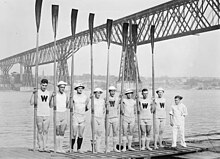A major contributor to this article appears to have a close connection with its subject. (August 2022) |
Walkway Over the Hudson | |
|---|---|
 | |
| Coordinates | 41°42′40″N 73°56′38″W / 41.711°N 73.944°W |
| Carries | Railroad (1889–1974) Hudson Valley Rail Trail (2009–present) |
| Crosses | Hudson River |
| Locale | Poughkeepsie, New York, to Highland, New York |
| Website | walkway |
| Characteristics | |
| Design | Cantilever deck truss bridge |
| Total length | 6,768 feet (2,063 m) |
| Width | 35 feet (11 m)[1] |
| Height | 212 feet (65 m) |
| Longest span | 2 × 548 feet (167 m) |
| No. of spans | 7 |
| Clearance above | Unlimited |
| Clearance below | 160 feet (49 m) |
| History | |
| Constructed by | Manhattan Bridge Building Company |
| Construction start | 1886 |
| Construction end | 1889 |
| Opened | January 1, 1889 (railroad) October 3, 2009 (walkway) |
Poughkeepsie-Highland Railroad Bridge | |
| Location | Poughkeepsie, New York |
| Coordinates | 41°42′38″N 73°56′40″W / 41.71056°N 73.94444°W |
| Built | 1886–1888 |
| Architect | John F. O'Rourke; Union Bridge Co. |
| NRHP reference No. | 79001577 |
| Added to NRHP | February 23, 1979 (original) May 20, 2008 (additional documentation)[2][3] |
| Location | |
 | |

The Walkway over the Hudson (also known as the Poughkeepsie Bridge, Poughkeepsie Railroad Bridge, Poughkeepsie–Highland Railroad Bridge, and High Bridge) is a steel cantilever bridge spanning the Hudson River between Poughkeepsie, New York, on the east bank and Highland, New York, on the west bank. Built as a double track railroad bridge, it was completed on January 1, 1889, and formed part of the Maybrook Railroad Line of the New York, New Haven and Hartford Railroad.
It was taken out of service on May 8, 1974, after it was damaged by a tie fire. It was listed on the National Register of Historic Places in 1979, and its entry updated in 2008.[2][3] The bridge was designated as a National Historic Civil Engineering Landmark by the American Society of Civil Engineers in 2009.[4]
It was reopened on October 3, 2009, as a pedestrian walkway as part of the new Walkway Over the Hudson State Historic Park. The New York State Bridge Authority owns and is charged with maintaining the bridge structure (as directed by the Governor and Legislature in July 2010). The park is operated by the New York State Office of Parks, Recreation and Historic Preservation.[5] In 2017, the walkway hosted 593,868 visitors.[6] The park connects the Hudson Valley Rail Trail in Highland to the Dutchess Rail Trail, and forms part of the Empire State Trail.[7]
At a length of 6,768 feet (2,063 m), it was the world's longest pedestrian footbridge from its opening[8][9][10] until October 2016, when it became the second-longest after being surpassed by the 7,974-foot (2,430 m) Mile Into the Wild Walkway in Keenesburg, Colorado, United States.[11][12] The Walkway over the Hudson now refers to itself as the world's longest elevated pedestrian bridge as it has a much higher elevation than the Mile Into The Wild.[13] The Walkway over the Hudson allows bicycles and the Mile Into The Wild does not. Also, the Walkway over the Hudson does not have an admission fee.
- ^ "Walkway Over the Hudson" (PDF). American Trails. Retrieved December 8, 2016.
- ^ a b "National Register Information System". National Register of Historic Places. National Park Service. April 15, 2008.
- ^ a b "New listings". National Park Service. May 30, 2008.
- ^ "Poughkeepsie-Highland Bridge Historical Marker". The Historical Marker Database. Retrieved March 6, 2021.
- ^ "Walkway over the Hudson Poughkeepsie Railroad Bridge". www.nysba.state.ny.us. Retrieved November 25, 2018.
- ^ Howland, Jack (March 1, 2018). "Dutchess state parks, Walkway see big gains in 2017". Poughkeepsie Journal. Retrieved November 25, 2018.
- ^ "Routes on the Empire State Trail". Welcome to the State of New York. November 17, 2017. Retrieved April 25, 2019.
- ^ Cite error: The named reference
WalkwayOpenswas invoked but never defined (see the help page). - ^ "Walkway Over the Hudson State Historic Park". New York State Parks, Recreation and Historic Preservation. Retrieved April 11, 2020.
- ^ "Walkway Over the Hudson State Historic Park". Poughkeepsie Journal. October 3, 2010. p. 4.

- ^ "Scott Lyttle on Instagram: "Pretty cool to be part of an official Guinness World Record today, doing the official survey measurement for the worlds [sic] longest footbridge..."". Instagram. Archived from the original on December 23, 2021. Retrieved April 11, 2020.
- ^ Mutual of Omaha's Wild Kingdom (March 19, 2018). Wild Kingdom – The Wild Animal Sanctuary – Walkway. YouTube. Archived from the original on December 21, 2021. Retrieved April 11, 2020.
- ^ https://walkway.org Visit